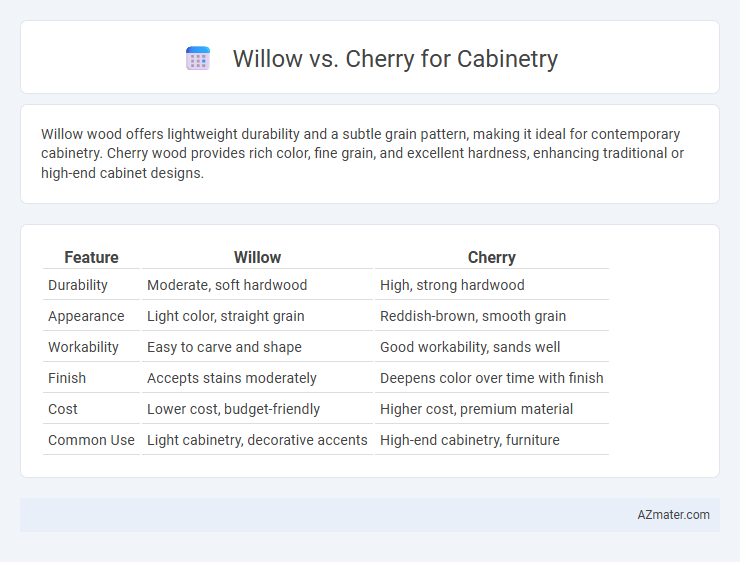Willow wood offers lightweight durability and a subtle grain pattern, making it ideal for contemporary cabinetry. Cherry wood provides rich color, fine grain, and excellent hardness, enhancing traditional or high-end cabinet designs.
Table of Comparison
| Feature | Willow | Cherry |
|---|---|---|
| Durability | Moderate, soft hardwood | High, strong hardwood |
| Appearance | Light color, straight grain | Reddish-brown, smooth grain |
| Workability | Easy to carve and shape | Good workability, sands well |
| Finish | Accepts stains moderately | Deepens color over time with finish |
| Cost | Lower cost, budget-friendly | Higher cost, premium material |
| Common Use | Light cabinetry, decorative accents | High-end cabinetry, furniture |
Introduction to Willow and Cherry Wood for Cabinetry
Willow wood for cabinetry is valued for its lightweight durability and warm, natural grain patterns that add a rustic charm to interior spaces. Cherry wood, renowned for its rich reddish-brown hue and smooth texture, ages gracefully by deepening in color and enhancing cabinetry elegance over time. Both woods offer distinct characteristics, with willow providing a softer, more textured appearance and cherry delivering a classic, polished finish ideal for traditional and contemporary kitchen designs.
Appearance and Grain Patterns: Willow vs Cherry
Willow cabinetry showcases a light, creamy color with subtle, soft grain patterns that create an airy and casual aesthetic, ideal for modern or rustic interiors. Cherry wood displays a rich, warm reddish-brown hue that deepens over time, featuring smooth, fine, and often wavy grain patterns that add elegance and sophistication to cabinetry. The distinctive grain of cherry wood contrasts with the understated look of willow, giving each material a unique visual appeal suited to different design preferences.
Durability and Strength Comparison
Willow cabinetry offers moderate durability with a fine, consistent grain that resists warping, while cherry wood is renowned for its exceptional strength and long-lasting resilience under heavy use. Cherry's dense hardwood structure provides superior resistance to dents and scratches compared to willow, making it ideal for high-traffic kitchen environments. The natural aging process of cherry also enhances its durability, developing a rich patina that maintains its integrity over decades.
Cost Differences in Willow and Cherry Cabinets
Willow cabinetry typically costs less than cherry due to its faster growth rate and greater availability, making it a budget-friendly option for homeowners seeking durability and aesthetic appeal. Cherry wood, known for its rich color and fine grain, commands a higher price point because of its slower growth, higher density, and premium status in cabinetry markets. The cost difference between willow and cherry cabinets can range from 20% to 40%, depending on wood grade, finish, and craftsmanship quality.
Workability and Ease of Fabrication
Willow wood offers moderate workability with a fine, even texture that machines well but can be prone to splintering during intricate cuts, making it suitable for straightforward cabinetry projects. Cherry wood excels in ease of fabrication due to its smooth grain and natural hardness, allowing for clean cuts, seamless sanding, and excellent finishing results. Cabinet makers favor cherry for intricate detailing and durability, while willow is more cost-effective for simpler constructions.
Color Variation and Aging Over Time
Willow cabinetry typically features a smooth, consistent grain with subtle color variations ranging from soft beige to light brown, which tends to mellow evenly over time, maintaining its warmth and elegance. Cherry wood offers a rich, reddish-brown hue with more pronounced grain patterns and darkens noticeably with age, developing a deep, lustrous patina that enhances its classic appeal. Both woods provide distinct aesthetic aging characteristics, with Willow favoring subtle evolution in tone and Cherry showcasing a dynamic darkening process that highlights its natural beauty.
Maintenance and Care Requirements
Willow wood cabinets require moderate maintenance, with regular dusting and occasional polishing to preserve their natural grain and prevent surface wear. Cherry wood demands more careful upkeep due to its susceptibility to darkening over time and sensitivity to sunlight, necessitating the use of protective finishes and avoidance of direct sunlight exposure. Both materials benefit from using mild cleaning agents and immediate attention to spills to maintain their appearance and durability.
Environmental Impact and Sustainability
Willow wood offers a lower environmental impact due to its rapid growth rate and ability to sequester carbon efficiently, making it a more sustainable choice for cabinetry. Cherry wood, while durable and prized for its rich color and grain, typically grows slower and requires more intensive forestry practices, increasing its ecological footprint. Choosing willow cabinetry supports sustainable forestry initiatives and reduces carbon emissions compared to cherry wood alternatives.
Popular Design Styles for Willow and Cherry
Willow wood in cabinetry often complements rustic, farmhouse, and traditional design styles due to its soft grain and warm, muted tones that enhance cozy and inviting spaces. Cherry wood is favored in classic, transitional, and formal cabinetry designs, offering rich reddish hues and smooth grain that develop a deep patina over time, adding elegance and sophistication. Both woods provide unique aesthetic qualities, with Willow suited for casual, natural looks and Cherry ideal for polished, upscale interiors.
Choosing the Right Wood: Willow or Cherry for Your Cabinets
Choosing between willow and cherry wood for cabinetry hinges on durability and aesthetic preferences; cherry offers rich, warm tones with a smooth grain and darkens gracefully over time, making it ideal for elegant, long-lasting cabinets. Willow, while less dense, provides a lighter color with a subtle texture, perfect for a more casual or rustic look but may be less resistant to dents and scratches compared to cherry. Consider the cabinet location and maintenance expectations, as cherry's hardness and color depth suit high-traffic areas, while willow suits spaces favoring lighter, softer wood surfaces.

Infographic: Willow vs Cherry for Cabinetry
 azmater.com
azmater.com